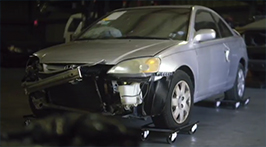Tire Season PSA Series: Tire Safety Danger
Approximately 33,000 tire-related crashes occur each and every year, resulting in about 19,000 injuries and hundreds of deaths. These types of crashes typically involve a tread-belt separation, followed by a loss of control over the vehicle. Sometimes the forces involved are so violent that the vehicle rolls over multiple times before coming to a rest.
The most dangerous type of tire failure is referred to as a “tread belt separation.” The modern steel-belted radial tires used on passenger cars and light trucks are commonly comprised of two steel belts that are held together by specialized rubber coatings, which are vulcanized or cooked together under pressure in a mold. A tread belt separation occurs when the rubber and steel belts break apart from one another. This catastrophic failure often happens as the vehicle is travelling at highway speeds, comprising the driver’s ability to maintain control over the vehicle.
Tread belt separations can be caused by a number of different problems. One common issue is that the tire was poorly designed—in other words, the tire was made with cheap materials that are not able to withstand everyday driving conditions. The tire may also have been poorly manufactured in a factory with low quality control standards.
Tires can also suffer a tread belt separation because of their age. Tires degrade over time due to the natural interaction between rubber and oxygen. As a result of this process, tires should be discarded after they have aged 6 years form their date of manufacture; otherwise, they stand an increased risk of failure. Unfortunately, clear guidance and information about tire aging is not readily available to the public; as a result, the average consumer is simply not aware that tires have a shelf life. Additionally, tires do not display their age in an easy to read fashion. Instead, the age of the tire is buried in a code on the sidewall, and most consumers do not understand how to decipher that code.
If you or a loved one has been involved a tire-related crash, you should make sure that you or your attorney are acting quickly to preserve both the scene and the relevant evidence, including the tire carcass, the tread, and the vehicles involved in the crash. Time is a critical factor in this process as pieces of the tread may go missing as the grass next to roadways is mowed, trash is picked up, etc. Additionally, it is vital to document where all of the evidence is located at the crash site. In particular, the location of pieces of tread that dislodged from the tire can be critical to establishing the existence of a defect that caused the crash. As a result, it is often best to conduct a formal survey of the crash site to ensure that the location of all vehicles and evidence is accurately documented and preserved.
Victims of tire-related crashes must know that there are time limitations on pursuing claims. Every state has a statute of limitations that will apply to a potential claim. Essentially, a statute of limitations requires a plaintiff to file a lawsuit within so many years of the crash, with certain exceptions contained in the statute and case law construing the statute. Many states also have a statute of repose. Unlike the statute of limitations, the statute of repose will typically bar a claim from being filed within a certain amount of years after the product was first manufactured or sold to a consumer.
Tire lawsuits are often the only means available for injured consumers and their families to obtain the financial relief needed to begin putting their lives back together after a tire-related crash. Tire lawsuits also serve as powerful economic incentives to force tire manufacturers and others to ensure that only safe tires reach our roadways. For these reasons, it is incredibly important for the victims of tire-related crashes to secure competent representation that will do everything needed to preserve and pursue the potential claims against the tire manufacturer and other responsible parties.
Approximately 33,000 tire-related crashes occur each and every year, resulting in about...
The Ford C-Max Energi Electric car is being blamed for starting more...
“The findings in this analysis conducted for The Safety Institute are disturbing,...
